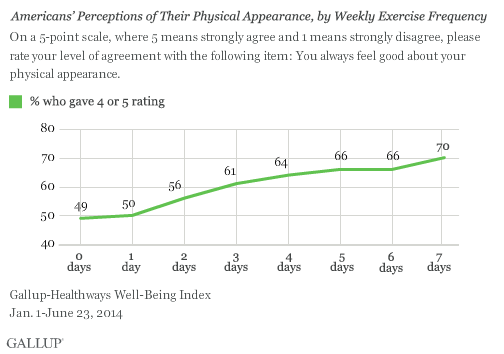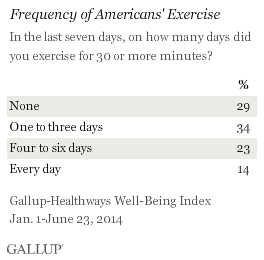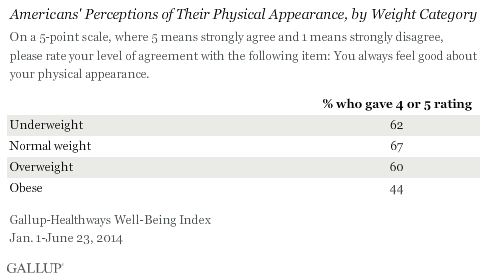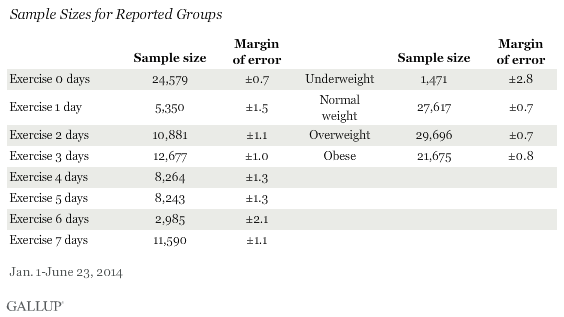Americans Who Exercise Most Feel Best About Appearance
WASHINGTON, D.C. — Americans who report exercising for 30 minutes every day in the past week feel best about their physical appearance, while those who exercise no more than one day in a given week feel the worst. Seventy percent of Americans who exercised for at least 30 minutes every day the prior week express agreement that they “always feel good” about their appearance, compared with half of those who say they exercised for at least 30 minutes one day (50%) or no days (49%). For the most part, each additional day per week that Americans exercise for 30 minutes or more is associated with at least a small increase in feeling good about their appearance.
These data are based on more than 80,000 interviews with U.S. adults from Jan. 1-June 23, 2014, as part of the Gallup-Sharecare Well-Being Index. Gallup asks Americans to rate their level of agreement with the statement, “I always feel good about my physical appearance” on a five-point scale, where “5” means strongly agree and “1” means strongly disagree. Overall, more than half of Americans, 58%, agree that they always feel good about their looks, answering with a 4 or a 5.
Fifty-six percent of Americans who exercise two days per week feel good about their looks. This jumps to the 60% range among those who exercise three to six times per week.
According to the U.S. Department of Health and Human Services, adults should engage in at least 2 hours and 30 minutes of “moderate intensity” physical activity “spread throughout the week.” While fitness professionals often frown on working out too frequently, and HHS does not offer guidance on how many days a week Americans should exercise, those who exercise daily seem to feel the best about their appearance.
Daily exercisers make up only about one in seven Americans (14%), however, while 29% report not exercising for 30 minutes on any day in the past week. A third of Americans (34%) report exercising for 30 minutes or more up to three days weekly, while 23% report exercising about four to six days per week, which is closer to the HHS recommendation.
The link between Americans’ frequency of exercise and feeling good about their appearance could reflect a variety of concurrent patterns. Exercise produces a number of benefits, including in particular lower weight, better health, higher muscle mass, and improved mood. Any or all of these perks could result in exercisers’ feeling better about the way they look. Plus, more self-confident people could feel good about their looks and therefore be more likely to want to maintain those looks.
Americans at Normal Weight Feel Best About Appearance
Weight status is clearly associated with how Americans feel about their physical appearance. Those who are obese are the least likely to feel good about their appearance (44%), while those who maintain a normal weight are most likely to feel this way (67%). Those who are overweight but not obese (60%) are much more likely to feel good about their appearance than those who are obese. Meanwhile, 62% of those who are underweight feel good about their appearance.
Bottom Line
These results underscore yet another reason why regular exercise is good for Americans — those who exercise more than once a week are significantly more likely to feel good about their physical appearance than those who don’t.
At the same time, the mechanisms at work in this relationship are not totally clear. Certainly, while regular exercise can help Americans maintain a normal weight and thus make them feel good about their appearance, those who are most concerned about their physical appearance may also be more motivated to exercise to maintain their appearance.
Physical activity releases endorphins into the brain that act as natural pain killers, and reduces stress, anxiety, and depression. In addition to helping individuals control their weight, exercise could also have a positive effect on how confident they are in their looks.
But 63% of Americans exercise for at least 30 minutes on three or fewer days per week — likely falling short of HHS’ recommended amount of exercise. In addition to weight control and other health benefits, exercising more frequently would likely improve Americans’ perceptions of their appearance.
SURVEY METHODS
Results are based on telephone interviews conducted as part of the Gallup-Sharecare Well-Being Index survey Jan. 1-June 23, 2014, with a random sample of 85,143 adults, aged 18 and older, living in all 50 U.S. states and the District of Columbia.
For results based on the total sample of national adults, the margin of sampling error is ±0.4 percentage points at the 95% confidence level. There error range is larger, however, for the subgroups reported here. For reporting relevant to days exercised per week, the maximum expected error ranges from about 1 to 2 percentage points. For reporting of the four BMI weight classes, the maximum expected error range is ±2.8 points for underweight and less than one point for all other weight classes.
Interviews are conducted with respondents on landline telephones and cellular phones, with interviews conducted in Spanish for respondents who are primarily Spanish-speaking. Each sample of national adults includes a minimum quota of 50% cellphone respondents and 50% landline respondents, with additional minimum quotas by time zone within region. Landline and cellular telephone numbers are selected using random-digit-dial methods. Landline respondents are chosen at random within each household on the basis of which member had the most recent birthday.
Samples are weighted to correct for unequal selection probability, nonresponse, and double coverage of landline and cell users in the two sampling frames. They are also weighted to match the national demographics of gender, age, race, Hispanic ethnicity, education, region, population density, and phone status (cellphone only/landline only/both, and cellphone mostly). Demographic weighting targets are based on the most recent Current Population Survey figures for the aged 18 and older U.S. population. Phone status targets are based on the most recent National Health Interview Survey. Population density targets are based on the most recent U.S. census. All reported margins of sampling error include the computed design effects for weighting.
In addition to sampling error, question wording and practical difficulties in conducting surveys can introduce error or bias into the findings of public opinion polls.
For more details on Gallup’s polling methodology, visit www.gallup.com.



